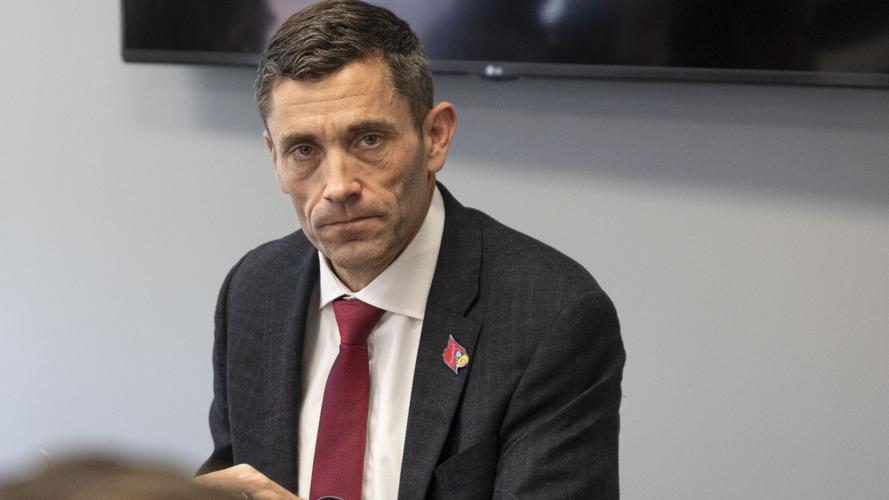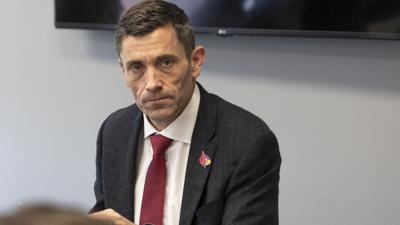LOUISVILLE, Ky. (WDRB) – Here, in brief, is the challenge facing University of Louisville (and every other Power 5) athletic department starting in the 2025-26 season: Find $22 million with which to pay players, the details and guidelines of which will be added in the coming months.
This is the House v. NCAA settlement in a nutshell. The NCAA is tired of losing in court. It is afraid of losing a major class-action case in court. And it is seeking a framework that will allow itself to stabilize as it converts fully to the new reality of athletes not only being able to make their own money off their Names, Images and Likenesses, but of being due a share of actual media rights revenues earned by their schools and conferences.
Add in an additional $2.5 billion or so in damages – essentially back payments -- to athletes who were denied a right to earn in the past, and you have a picture of the liability the NCAA and its schools are facing over the next 10 years (the length of the deal).
The timing of the settlement could be better for U of L. Record-low basketball attendance has presented a revenue challenge for the school, though improving football fortunes and a hoped-for basketball revival could help turn the picture around fairly quickly. (Having only six home football games next season, though, won’t help.)
Regardless, the money has to come from somewhere. Athletic director Josh Heird acknowledged in a recent interview, “We don’t have $20 million sitting around, I can promise you that.”

So, Louisville, like everyone else, will have to find the money, whether it’s in new revenue, reduced spending, cuts or reallocations. It’s the new normal – for now. Somewhere, schools will have to find a way to carve out a $20-$22 million piece of the pie for their athletes.
How? Nobody is quite sure.
“I don't think there's a better example of building an airplane while you're flying it than what we're going through right now,” Heird said.
For schools in the SEC or Big Ten, that may be less of a burden. The SEC is set to begin its first season of a 10-year, $3 billion rights deal with ESPN. The Big Ten announced a seven-year, $8 billion deal with NBC, CBS and FOX last year. Those leagues are sending major cash infusions to their members to help offset costs. But even for schools at the top end of the revenue spectrum, adding a $20 million line item is no small thing.
The ACC distributed an average of $44.8 million to its football playing members in 2024, but that number won’t grow significantly, while the Big Ten and SEC widen the revenue gap.
All of which creates a challenging landscape for Louisville, which has begun to prepare a strategy for meeting the new revenue-sharing challenge without really yet having a playbook.
Recently, Heird spent some time with WDRB to talk about the school’s approach. The following Q&A with WDRB’s Eric Crawford tackles some of the basic questions, knowing that answers sometimes are simply not available without more specifics of the rules that the settlement lays out, such as whether the payments are subject to Title IX law.
The following are some edited excerpts from that conversation.
CRAWFORD: The House settlement is being talked about everywhere. What are your initial thoughts and some of the challenges as Louisville starts to put together an approach to this?
HEIRD: I think the hardest part is trying to answer questions when you have multiple variables that you don't know the answer to. Like, 5 + x = 8, it’s pretty easy to figure out x. But 5 + x + x + x = 12, well, I’m not sure what those other three numbers are. And I’ve kind of forgotten how to do algebra. So I think that’s what we’re trying to sort through. Like, take Title IX, for example. If we have to do a 50-50 split (of payments), from a revenue standpoint, that changes the equation dramatically. So there are a lot of questions, and there’s just not enough concrete information to say, “All right, we can take this path now.” Roster limits are another question. What does that look like, when you start trying to have those conversations on the ideal roster size for 23 sports? And, obviously, we’re essentially adding a $20 million expense to every Power 5 athletic budget. And you’re taking away some of the revenue, call it $1 million or $1.5 million that is going to be deducted from NCAA disbursements every year.
CRAWFORD: You mention the $20 million in estimated player payments. Where does that money come from?
HEIRD: Well, the first thing you have to look at – and these questions aren’t on the micro level, but the macro – is look at expenses and budgets, and at how college sports operate. There was a quote from Trev Alberts recently, and he said essentially, “College athletics has an expense problem.” You know, to me that encapsulates so much, because it's always just been, “We'll figure it out and we'll pay for it.” Well, there is no just “figure-it-out” now with $20 million. It's like, how do we really look at how we function as an enterprise and do things differently from seasons to championships to all of that?

Louisville athletic director Josh Heird with president Kim Schatzel at Louisville's game against Georgia Tech in Atlanta on Sept. 1, 2023.
The best example that I could give you, as far as a way to think differently, is our track coach, after Kentucky just hosted the NCAA regionals and first round of track and field. And Monday, he says, “This meet so pointless. We have to qualify to go to the national championship meet in outdoors. But indoors, it's just a descending order list – just top 24 kids with the top 24 times and you go to the national championship. But for some reason, we've stuck another whole two meets in here, one east of the Mississippi, one west of the Mississippi.” I imagine that adds up to millions of dollars in travel costs, and it's a four-day meet. So, it's four days in hotels for a lot of these teams. Those are the decisions I'm talking about. How do we just look at every sport and everything that we're doing and say, “All right, here's an opportunity for us to do things differently and save some dollars?”
Then once you've done that, you're not going to say, “We've saved $20 million.” I'm not foolish to think we're going to do that. But then you start once again, putting that formula together to say, “Could we pick up a million dollars here and, you know, ticket revenue, could we pick up more, in all those buckets that you have?” And can you stretch it to that $22 million? And from the collective and NIL standpoint, are those dollars going to kind of get shifted back? . . . Can some of those dollars get pulled back internally into the university? I think there's opportunity there.
CRAWFORD: So, what happens to collectives? Do they have a role in this, or do they have a bigger role at schools where there’s less media money?
HEIRD: I think collectives become more of cherry on top, I kind of term it. Let’s say school, X is going to pay X for your NIL and school Y is going to pay you Y and they're pretty similar, because, you know, everybody has the $20 million that they can spend. So, I think those numbers are going to be fairly similar. But then does a collective have the ability to come in and say, hey, we can also provide you a car and a place to live and some different things like that. Maybe classify it more as a fringe benefit opportunity -- and I want to be really careful not to compare this to an employment offer, or a job offer. . . . And are the 18-to-22-year olds going to have the ability and are they going to surround themselves with people that can make the those decisions as opposed to saying, well, this one's more money,
CRAWFORD: I keep hearing that the thing this settlement does is provide stability? Do you think it does?
HEIRD: I think it provides the first step in an opportunity to provide stability. Stand-alone, I'm not sure that it does. But I think it is providing the opportunity for US college athletics leadership, conference commissioners, (NCAA president) Charlie Baker to go to lawmakers or Congress and say, “Look, we understand that we didn't do a very good job of managing this enterprise through the last, 15 years, and we are writing those wrongs with this settlement. And we're trying to take steps forward to fix this thing, but we can't do it by ourselves, we need some help.” I think that is the best opportunity for us to really stabilize it. And I don't think that opportunity was ever going to come about until we put this in the rearview mirror.
. . . To me, it's almost a foundational piece as far as how we move forward. If you took it, this isn't the problem solver. This isn't the answer to all of our questions. But it allows us to begin to answer more of our questions. And if we wouldn't have done this, then we wouldn't have the ability to really move forward at all. I think that's the benefit of it. . . .
CRAWFORD: How much concern do you have in terms of Louisville’s ability to meet that revenue challenge and stay on the front edge of this new landscape?
HEIRD: I've got to have some hope in the leadership of the department, Eric. Right? Look, I think I worry about it every day. You know, I worry about it every day. But I worried about NIL, and are we going to be able to compete on that stage? And what are we doing to compete on that stage and get out and get things done, I think that's where I do have some confidence is I feel like we've navigated the NIL space pretty effectively. And we've done it by being creative. We haven't done it by spending the most money.
We've done it by hiring really good, strong leaders with our coaches, who have the ability to say, “Hey, don't just go spend the most money, let's find the right fit, as far as who the student athletes are going to be at Louisville.” I think we're going to have to do the same here. We don't have $20 million sitting around, I can promise you that. But I think we have the ability to find creative ways to try to generate revenue, reduce expenses, and say we're going to be able to compete at the level that we expect to compete at.
TOMORROW: Josh Heird talks about the ACC, its potential approach to the new NCAA landscape and Louisville’s place in it.
Copyright 2024 WDRB Media. All Rights Reserved.














